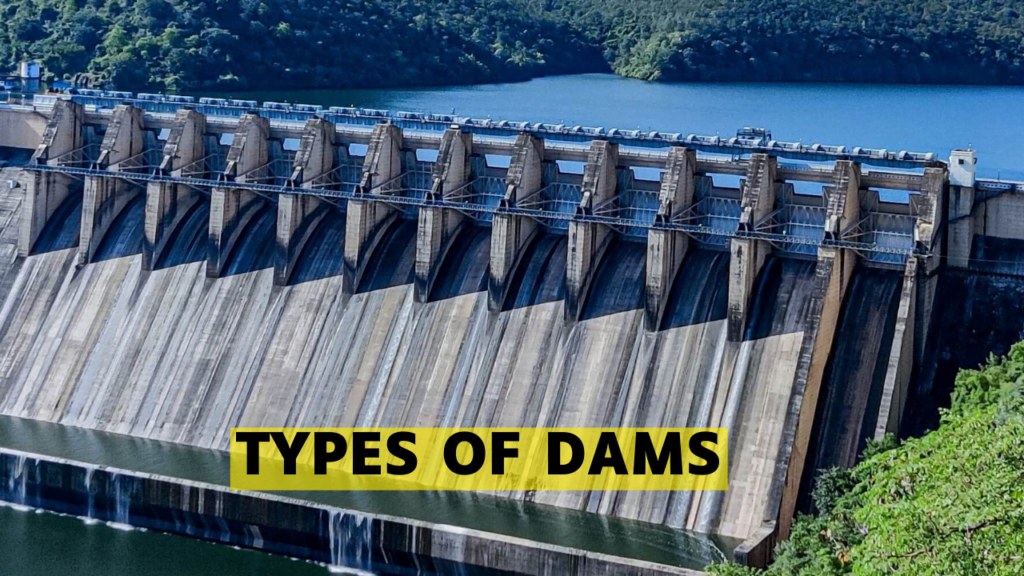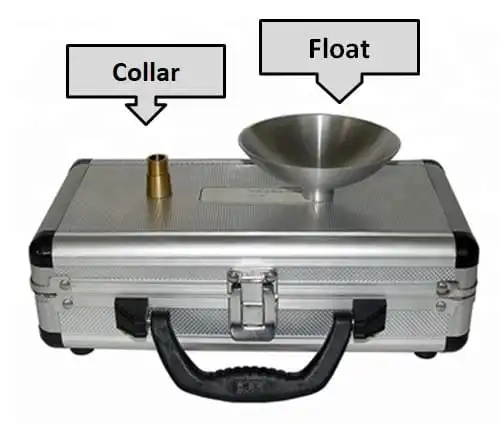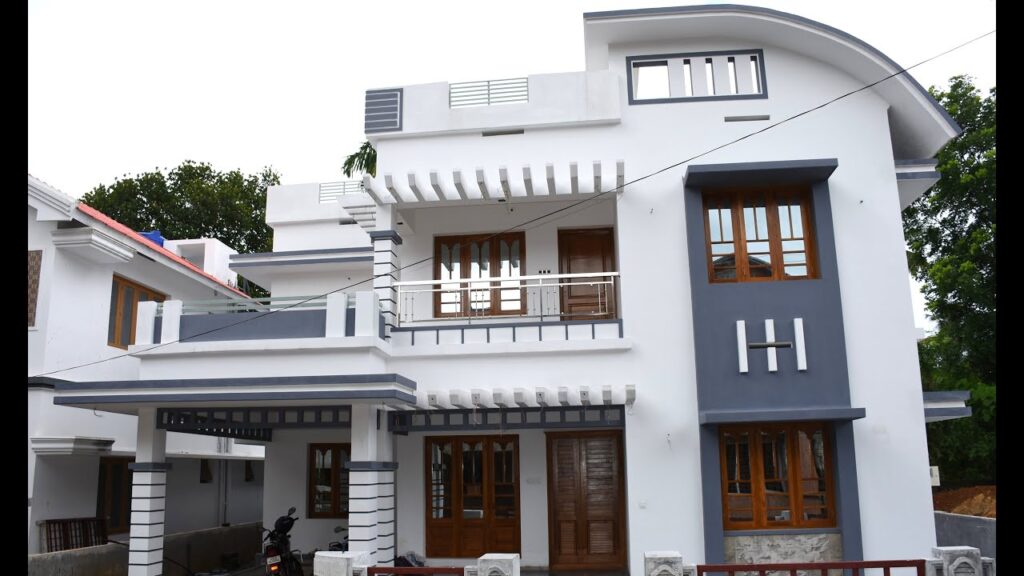A dam is a hydraulic structure that is built across a river and mostly composed of impermeable materials. Its purpose is to create an upstream reservoir where water may be impounded for various purposes. These might include hydropower, irrigation, flood control, fishing, recreation, navigation, and water supply. Dams may be constructed to fulfill a variety of purposes, or they can be built for only one of the purposes stated above. As a result, dams may be classified as single- or multifunctional.
Differentiating features and names for dams
- Crest: The top of the dam. They could be used in certain circumstances to construct a boardwalk or road over the dam.
- Parapet walls: Parapet walls are the low-protective barriers on each side of the road or the crest walkway.
- Heel: The portion of the dam where the upstream side and the land or riverbed meet.
- Toe: The portion of the dam known as the toe is where the riverbed or land meets the downstream side.
- Spillway: An opening made at the top of a dam to let extra or surplus water from the reservoir escape is called a spillway.
- Abutments: The valley slopes on each side of the wall to which the left and right ends of the dam are fixed.
- Gallery: A transverse or longitudinal route within the dam that is level or gently sloping and resembles a small chamber. It has a floor drain to collect seepage water. They are often added to allow for the drilling of grout and drainage holes. These might also be utilized to provide space for the apparatus required to keep an eye on how the dam is operating.
- Sluice way: A hole in the dam at the base intended to drain the reservoir of silt accumulation.
- Free board: The term “free board” refers to the region between the top of the dam and the highest point of the reservoir’s water level.
- Inactive Storage Level: The water level in the permanent storage that cannot be lowered.
- Diversion Tunnel: A diversion tunnel is one that is constructed to redirect or divert water away from the location where a dam is being constructed. The dam is being built as the water travels through the diversion tunnel.
Various types of dams
For dams, there are several classifications. Nonetheless, the most often used classification systems for dams are listed below:
The following categorization is made possible by a dam’s functions:
Storage dams: They are constructed to retain water when rivers overflow during the rainy season. A number of small dams collect spring runoff to be used during the dry summer months. Storage dams may also provide water and improve the habitat for fish and other animals. They might be used to store water for hydroelectric power generation, flood control projects, or agricultural purposes. Storage dams are the most common kind of dam; unless specified differently, a dam is a storage dam.
Diversion dams: Known also as conduits, diversion dams are constructed to reroute river water into off-taking canals. They provide sufficient power to push water into ditches, canals, and other conveyance systems. These smaller dams are used for farming and to redirect streams to distant storage reservoirs. A diversion dam is usually not very tall and contains a small upstream storage reservoir. The diversion dam diverts water and features a small storage space, much as a storage weir. Weirs and diversion dams are sometimes used interchangeably.
Detention dams: These types of dams are constructed to control floods. During floods, a detention dam slows the river’s downstream flow by holding onto some floodwater. Consequently, the effect of unplanned floods is lessened. After that, the reservoir’s water is gradually released at a controlled rate determined by the carrying capacity of the downstream detention dam’s channel. As a result, flooding is prevented in the area below the dam.
Debris dams: A debris dam is constructed to retain materials that flow with water in a river, such as sand, gravel, and drift wood. When water passes over a debris dam, it is often clear.
Coffer dams: These are barriers constructed around a construction site with the purpose of keeping water out so that work may be done during the dry season. Thus, a cofferdam is a makeshift dam constructed to facilitate construction. In order to divert water into a diversion tunnel or channel while the main dam is being constructed, a coffer dam is usually constructed upstream of the dam. When there is minimal river flow while the dam is being constructed, the site is sometimes encircled by a coffer dam and pumped dry. There are times when a coffer dam downstream of the dam is also required.
Based on their construction and design, dams may be divided into the following categories:
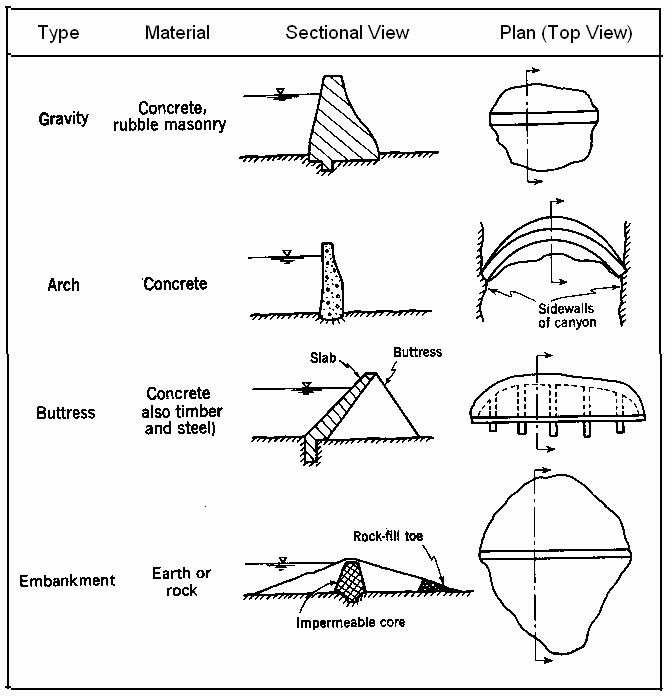

Gravity Dams: A gravity dam is a substantial dam composed of concrete or stonemasonry. Their function is to hold enormous volumes of water. The weight of the concrete dam can sustain the horizontal force of the water against it. This is why it is referred to as a gravity dam. Water cannot dislodge the dam since gravity effectively holds it to the ground.
When it comes to blocking rivers in wide valleys or narrow ravines, gravity dams are an efficient solution. Because gravity dams rely on their own weight to retain water, they must be built on a solid underlying base.
Gravity dams include the Grand Coulee Dam in the United States, the Nagarjuna Sagar Dam in India, and the Itaipu Dam that separates Brazil and Paraguay.

Earth Dams: In order to build an earth dam, successive earth layers are compacted, the most impermeable materials are formed into a core, and more permeable materials are added to the upstream and downstream borders of the dam. In the case that water exceeds the dam, a sizable spillway, usually composed of concrete, prevents catastrophic washout and blocks wind and rain damage.
The main factor that allows an earth dam to endure forces is the soil’s shear strength. Even while the earth dam’s weight also helps to withstand the stresses, its structural behavior is quite different from that of a gravity dam. Generally, flat slopes on the sides or wide valleys with abutments are where earth dams are built.They may be built in places with weaker foundations since the foundation requirements are less stringent than those for gravity dams. They may be built on any sort of foundation. Still, the height of the dam will depend on how strong the foundation is.
The Rongunsky Dam in Russia and the New Cornelia Dam in the United States are two examples of earthfill dams.
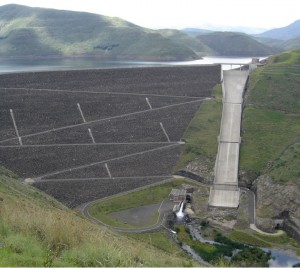
Rockfill Dams: Rockfill dams are constructed from large boulders and fragmented rock fragments. On the upstream side of the rockfill, an impermeable membrane is put to reduce seepage through the dam. Typically, the membrane is made of cement or asphaltic concrete. Wooden and steel membranes were also used in the building of rockfill dams until they were rendered obsolete.
A dry rubble cushion is placed between the membrane and the rockfill to help disperse the water load and maintain the membrane. Occasionally, rather of using an impermeable upstream membrane, an impermeable earth core is placed into the heart of rockfill dams to stop seepage. The earth’s core is pressed up against a layer of rockfill. There must be enough filters between the earth core and the rockfill on both the upstream and downstream sides of the core in order to stop soil particles from being carried by water and pipes. Generally, side slopes of rockfill are kept at a ratio of 1.4:1 (or 1.3:1) to the rock’s angle of repose. Compared to clay dams, rockfill dams need a stronger base.
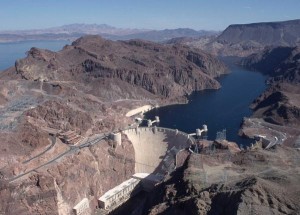
Mica Dam in Canada and Chicoasen Dam in Mexico are two examples of rockfill dams.
Arch Dams: An arch dam has a curved plan and a convex form toward the upstream side. The primary method of transmitting water pressure and other forces to the abutments of an arch dam is via arch motion. An arch dam is a suitable solution for tiny valleys with sturdy sides that can bear the force generated by the arch movement.
The section of an arch dam is generally triangular in form, however considerably thinner than that of a gravity dam. The arch dam may have two curvatures or one curvature in the vertical plane. Double-curvature arch dams are really more economical in many cases.
The Hoover Dam in the USA and the Idukki Dam in India are examples of arch dams.
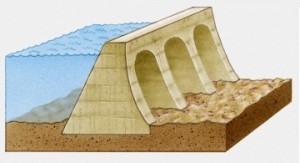
Buttress Dams: The deck type, the multiple-arch type, and the massive-head type are the three types of buttress dams. A deck-type buttress dam consists of a sloping deck that is supported by buttresses. Buttresses are triangle-shaped concrete barriers that transfer water pressure from the deck slab to the foundation. Buttresses are members of the compression. However, buttresses are typically positioned every 6 to 30 meters around the dam site, depending on the size and shape of the dam. Buttress dams are sometimes called hollow dams because the buttresses do not form a continuous wall that spans a river valley.The buttresses support a reinforced concrete slab that functions as the deck and are typically spaced equally apart.
In a multiple-arch type buttress dam, horizontal arches supported by buttresses serve as the deck slab. The arches are often narrowly spanned and made of concrete. A massive-head type buttress dam does not have a deck slab. Not the deck, but the upstream margins of the buttresses flaring, is what creates the massive heads that span the gap between the buttresses. However, buttress dams use less concrete than gravity dams. However, they may not be any less costly than gravity dams since they need additional form work, reinforcing, and skilled labor. Compared to gravity dams, buttress dams often have less demanding foundation requirements.
Buttress dams include the Bartlett Dam in the USA and the Daniel-Johnson Dam in Canada.
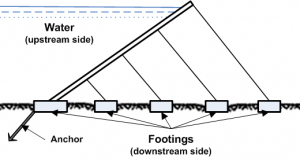
Steel Dams: A steel structure with a steel skin plate facing upstream constitutes a steel dam. Steel dams may be divided into two primary categories: (i) direct-strutted steel dams and (ii) steel cantilevered dams. Slanted struts in a direct strutted steel dam convey the water pressure directly to the foundation. A curve that creates a cantilever truss supports the upper part of the deck on a cantilever type steel dam. The tensile stress caused by this layout may be reduced by fastening the deck girder into the foundation at the upstream toe. Hovey suggested that strain at the upstream toe may be reduced by leveling the slopes of the lower struts in the bend. However, the struts would need larger parts. Restructuring the curve such that the weight of the water on the lower deck counteracts the moment caused in the cantilever is another approach to reduce stress. But this arrangement would need bracing, which would increase the cost. These are quite costly and prone to corrosion. These dams are almost too old. Steel dams are often used as temporary coffer dams while permanent dams are being constructed. Wood or earthfill are placed to the inside side of steel coffer dams to make them waterproof. The area between the coffer dams is dewatered to make dry construction of the permanent dam possible.
In the United States, Ashfork-Bainbridge and Redridge are two examples of steel dams.
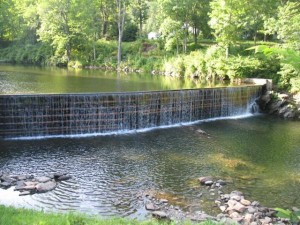
Timber Dams: Wood, mostly coniferous species like fir and pine, makes up the principal load-bearing structural elements of a timber dam. Based on the shape of the apron, timber dams are categorized as pile, crib, pile-crib, and buttressed dams. They are usually made for small heads (2-4 m or, occasionally, 4-8 m) and often include sluices.
Adjacency limits the size of timber dam openings; if a sluice is very long, intermediate supports like buttresses, piers, and posts divide the sluice into many openings. To hide the holes, wooden shields are often placed one over the other in a row. Simple hoists, which might be fixed or mobile winches, are used to lift and lower the shields.

